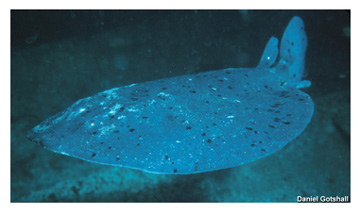Radio Program
Our regular Science and the SeaTM radio program presents marine science topics in an engaging two-minute story format. Our script writers gather ideas for the radio program from the University of Texas Marine Science Institute's researchers and from our very popular college class, Introduction to Oceanography, which we teach to hundreds of non-science majors at The University of Texas at Austin every year. Our radio programs are distributed at to commercial and public radio stations across the country.
Greenland is one of the least green spots on the planet. It’s a slab of rock covered with ice. In recent years, though, its ice cap has been shrinking. It’s been losing huge amounts of ice each year, as ice melts during the summer, but isn’t replenished during the winter.
A scallop’s best friend just might be a big shark.
{mosimage}
A recent study concluded that the lack of big sharks is helping wipe out beds of bay scallops along the East Coast. The study shows once again that weakening one link of the global food chain can have an impact on the others.
A scallop’s best friend just might be a big shark.
A recent study concluded that the lack of big sharks is helping wipe out beds of bay scallops along the East Coast. The study shows once again that weakening one link of the global food chain can have an impact on the others.
If the weather in your part of the country was wetter than normal last winter, blame it on El Niño. If it was drier than normal -- or colder, or warmer, or windier -- well, blame El Niño.
When a fish known as Torpedo californica locates its prey, it glides in slowly. When it’s within a few inches, it lunges, enfolds the prey like a tortilla wrapping around a piece of skirt steak, then stuns it with an electric shock of up to 50 volts.

If you dive a few hundred feet into any ocean and shine a flashlight into the dark, chances are you’ll see a flurry of small flakes all around you. The flakes are known as “marine snow.” They’re not flakes of frozen water, though, but slimy clumps of small organisms and other matter that are falling toward the ocean floor. They’re an important source of energy for life at greater depths, and they help reduce global warming.
The land often feeds the sea. Nutrients from the land wash into the sea, where they support the tiny organisms that form the first link in the food chain. In some places, though, it works the other way around -- the sea provides the nutrients to support life on land.

The next time you walk barefoot on the beach, and let the wet sand squish between your toes, think about this: You might be walking through the homes of thousands of tiny creatures.

The oceans are the cradle of life. The first known life on Earth appeared in the oceans at least three and a half billion years ago -- a type of one-celled organism known as cyanobacteria. They gave rise to more complicated lifeforms later on. And they also helped make modern-day life possible by pumping oxygen into the air and water.


